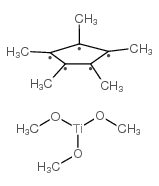Pentamethylcyclopentadienyltitanium trimethoxide
Modify Date: 2024-01-02 10:12:29

Pentamethylcyclopentadienyltitanium trimethoxide structure
|
Common Name | Pentamethylcyclopentadienyltitanium trimethoxide | ||
|---|---|---|---|---|
| CAS Number | 123927-75-3 | Molecular Weight | 276.19500 | |
| Density | 1.081 g/mL at 25 °C(lit.) | Boiling Point | 285 °C(lit.) | |
| Molecular Formula | C13H24O3Ti | Melting Point | N/A | |
| MSDS | N/A | Flash Point | 141 °F | |
| Name | carbanide,cyclopenta-1,3-diene,methanolate,titanium |
|---|---|
| Synonym | More Synonyms |
| Density | 1.081 g/mL at 25 °C(lit.) |
|---|---|
| Boiling Point | 285 °C(lit.) |
| Molecular Formula | C13H24O3Ti |
| Molecular Weight | 276.19500 |
| Flash Point | 141 °F |
| Exact Mass | 276.12000 |
| PSA | 27.69000 |
| LogP | 3.26330 |
| Index of Refraction | n20/D 1.554(lit.) |
Synonym: Section 2 - COMPOSITION, INFORMATION ON INGREDIENTS
Risk Phrases: None Listed. Section 3 - HAZARDS IDENTIFICATION EMERGENCY OVERVIEW
Not available. Potential Health Effects Eye: May cause eye irritation. Skin: May cause skin irritation. May be harmful if absorbed through the skin. Ingestion: May cause irritation of the digestive tract. May be harmful if swallowed. Inhalation: May cause respiratory tract irritation. May be harmful if inhaled. Chronic: Not available. Section 4 - FIRST AID MEASURES Eyes: Flush eyes with plenty of water for at least 15 minutes, occasionally lifting the upper and lower eyelids. Get medical aid. Skin: Get medical aid. Flush skin with plenty of water for at least 15 minutes while removing contaminated clothing and shoes. Ingestion: Get medical aid. Wash mouth out with water. Inhalation: Remove from exposure and move to fresh air immediately. Notes to Physician: Treat symptomatically and supportively. Section 5 - FIRE FIGHTING MEASURES General Information: As in any fire, wear a self-contained breathing apparatus in pressure-demand, MSHA/NIOSH (approved or equivalent), and full protective gear. Will burn if involved in a fire. Combustible liquid. Extinguishing Media: Use water spray, dry chemical, carbon dioxide, or chemical foam. Section 6 - ACCIDENTAL RELEASE MEASURES General Information: Use proper personal protective equipment as indicated in Section 8. Spills/Leaks: Absorb spill with inert material (e.g. vermiculite, sand or earth), then place in suitable container. Remove all sources of ignition. Use a spark-proof tool. Section 7 - HANDLING and STORAGE Handling: Use spark-proof tools and explosion proof equipment. Avoid breathing dust, vapor, mist, or gas. Avoid contact with skin and eyes. Handle under argon. Storage: Keep away from sources of ignition. Store in a cool, dry place. Store in a tightly closed container. Store under argon. Section 8 - EXPOSURE CONTROLS, PERSONAL PROTECTION Engineering Controls: Use adequate ventilation to keep airborne concentrations low. Exposure Limits CAS# 123927-75-3: Personal Protective Equipment Eyes: Not available. Skin: Wear appropriate protective gloves to prevent skin exposure. Clothing: Wear appropriate protective clothing to prevent skin exposure. Respirators: Follow the OSHA respirator regulations found in 29 CFR 1910.134 or European Standard EN 149. Use a NIOSH/MSHA or European Standard EN 149 approved respirator if exposure limits are exceeded or if irritation or other symptoms are experienced. Section 9 - PHYSICAL AND CHEMICAL PROPERTIES Physical State: Liquid Color: Not available. Odor: Not available. pH: Not available. Vapor Pressure: Not available. Viscosity: Not available. Boiling Point: 285 deg C @ 760 mmHg Freezing/Melting Point: Not available. Autoignition Temperature: Not available. Flash Point: 60 deg C ( 140.00 deg F) Explosion Limits, lower: Not available. Explosion Limits, upper: Not available. Decomposition Temperature: Solubility in water: Specific Gravity/Density: 1.081 Molecular Formula: C13H24O3Ti Molecular Weight: 276.21 Section 10 - STABILITY AND REACTIVITY Chemical Stability: Stable. Conditions to Avoid: Incompatible materials, exposure to moist air or water. Incompatibilities with Other Materials: Strong oxidizing agents. Hazardous Decomposition Products: Carbon monoxide, carbon dioxide, titanium/titanium oxides. Hazardous Polymerization: Will not occur. Section 11 - TOXICOLOGICAL INFORMATION RTECS#: CAS# 123927-75-3 unlisted. LD50/LC50: Not available. Carcinogenicity: Trimethoxy(pentamethylcyclopentadienyl) titanium(IV) - Not listed by ACGIH, IARC, or NTP. Section 12 - ECOLOGICAL INFORMATION Section 13 - DISPOSAL CONSIDERATIONS Dispose of in a manner consistent with federal, state, and local regulations. Section 14 - TRANSPORT INFORMATION IATA Shipping Name: Flammable liquid, n.o.s.* Hazard Class: 3 UN Number: 1993 Packing Group: III IMO Shipping Name: Flammable liquid, n.o.s. Hazard Class: 3.3 UN Number: 1993 Packing Group: III RID/ADR No information available. Section 15 - REGULATORY INFORMATION European/International Regulations European Labeling in Accordance with EC Directives Hazard Symbols: Not available. Risk Phrases: Safety Phrases: S 24/25 Avoid contact with skin and eyes. WGK (Water Danger/Protection) CAS# 123927-75-3: No information available. Canada None of the chemicals in this product are listed on the DSL/NDSL list. CAS# 123927-75-3 is not listed on Canada's Ingredient Disclosure List. US FEDERAL TSCA CAS# 123927-75-3 is not listed on the TSCA inventory. It is for research and development use only. SECTION 16 - ADDITIONAL INFORMATION N/A |
| Risk Phrases | R36/37/38:Irritating to eyes, respiratory system and skin . |
|---|---|
| Safety Phrases | S24/25 |
| RIDADR | 1993 |
| WGK Germany | 3 |
| Titanium,trimethoxy[(1,2,3,4,5-h)-1,2,3,4,5-pentamethyl-2,4-cyclopentadien-1-yl] |
| Pentamethylcyclopentadienyltitanium trimethoxide |
| (Pentamethylcyclopentadienyl)trimethoxytitanium |
| 1,3-Cyclopentadiene,1,2,3,4,5-pentamethyl-,titanium complex |
| Trimethoxy(pentamethylcyclopentadienyl) titanium(IV) |
| Trimethoxy(pentamethylcyclopentadienyl)titanium |
| MFCD00269850 |